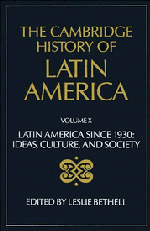Book contents
- Frontmatter
- 1 The multiverse of Latin American identity, c. 1920–c. 1970
- 2 Latin American narrative since c. 1920
- 3 Latin American poetry, c. 1920–1950
- 4 Latin American poetry since 1950
- 5 Indigenous literatures and cultures in twentieth-century Latin America
- 6 Latin American music, c. 1920—c. 1980
- 7 Latin American architecture, c. 1920–c. 1980
- 8 Latin American art since c. 1920
- 9 Latin American cinema
- 10 Latin American broadcasting
- Bibliographical essays
8 - Latin American art since c. 1920
Published online by Cambridge University Press: 28 March 2008
- Frontmatter
- 1 The multiverse of Latin American identity, c. 1920–c. 1970
- 2 Latin American narrative since c. 1920
- 3 Latin American poetry, c. 1920–1950
- 4 Latin American poetry since 1950
- 5 Indigenous literatures and cultures in twentieth-century Latin America
- 6 Latin American music, c. 1920—c. 1980
- 7 Latin American architecture, c. 1920–c. 1980
- 8 Latin American art since c. 1920
- 9 Latin American cinema
- 10 Latin American broadcasting
- Bibliographical essays
Summary
introduction
Beginning in the 1870s Latin American art was gradually transformed by a dual phenomenon. On the one hand, increasing numbers of European (especially French, Italian and Spanish) teachers of drawing, painting and sculpture—some recruited, others simply on a ‘cultural adventure’—arrived in the New World. At the same time increasing numbers of young Latin American artists, with scholarships or prizes if they did not have private resources, departed for Europe to pursue their studies in Paris, Florence, Rome, Madrid or some other centre of Western European art. Most Latin Americans returned to their own countries, either to teach or, commissioned by the government, to depict images of national heroes in bronze or on canvas, immortalizing the principal events of independence in large-scale works of art. Simultaneously, however, monumental change—in part a struggle against the inertia of the academies—was taking place in the art world in a number of different European cities: principally in Paris, but also in Vienna, Amsterdam, Berlin and Moscow. It was not for the avant-garde artists of Europe at first simply a question of subject matter, but something more immediate: the treatment of sunlight, the use of colour, as well as the validity of everyday themes which were considered pedestrian by the academies. In other cases, the driving force behind the new painting was the reinterpretation of the artists’ own landscape or the assimilation of non-Occidental forms of art. In a word, the flight from the classical canons, a flight to which photography partly contributed, opened a door to other ways of perceiving and interpreting reality.
- Type
- Chapter
- Information
- The Cambridge History of Latin America , pp. 393 - 454Publisher: Cambridge University PressPrint publication year: 1995



